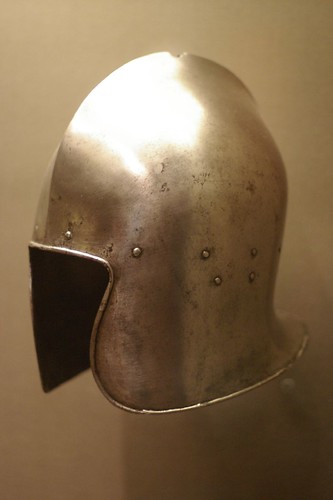More from MyArmoury:
Fig. f.
There are a couple of very poor quality pictures in Vol. 2 of Best Of The Hammer, pp. 150-151, illustrating an article on the development of armor in Scotland.
Finding the Site Record for Iona, Iona Abbey Museum finally got some pics. Oughtta bookmark this one.
This effigy is in very high relief. O for some profile shots of this and similar slabs! The helmet, more gracefully formed now, appears to come well down to around the angle of the jaws. Click image to enlarge a little less than 2x.
Another Ionan effigy
Effigy w/Spear, Shield with Heraldry, and late-lobate-pommel Sword This one has a more strikingly bascinetish helmet. Again, a closer look from either side of the head is wanted.
This fellow, included for thoroughness' sake as the details of his pointy helmet are perished, seems to have borne a heraldic cognizance of the Lords of the Isles on his heater shield. A ship and a rampant lion are discernible. Shield w/guige, spear, sword, lengthy dangling belt end, cotun? Possible plate armor on legs.
Sounds like for any armor hobbyist sojurning in that corner of the Hebrides, a day on tiny Oransay is worthwhile, being but little documented on the 'Net, viz.:
A visit to Oronsay Priory is recommended but only for the fit enthusiast! Oronsay is a small island off the West Coast with a population of eight in 1991. Take the ferry from Oban to Scalasaig on the Island of Colonsay. Follow the B8086 from the ferry east, turn left (south) on the B8055, a distance of about three miles - either on foot or take the post bus - to The Strand which separates the two islands. The Strand, about a mile in length, can be crossed at low tide by foot on a designated path and it is then about a mile's walk to the priory. The ruins are delightful, second only to Iona. There are over thirty medieval monuments - both carved stones and effigies - which are housed in roofed building.
From
http://www.churchmonumentssociety.org/newfile10.htm
O'Cahan tomb at Dungiven Priory, Ireland These pics aren't detailed enough to be useful right off, but it's another research destination if anyone ever gets there. This one tomb has numerous be-cotuned warriors complete with helmets depicted.
Back to Iona -- hey, look!
Front and side views of what appears to be the same effigy, side view at top of page and frontal view lower right. If they are, they show a central crease, with a symmetrical profile that's more like a fairly tall conical than the profiles we expect from bascinets. Pics are small, but clear, and better than nothing.
There's an effigy described for the Parish Church of Kilninian as follows:
There are eight interesting medieval slabs mostly of the Iona school 14th-15th century. Unfortunately the names of the people they commemorate are unknown. One is a full-length effigy 'of a warrior in armour 'with pointed basinet, an aventail and a knee-length aketon and carries a claymore'. He has a tasselled cushion under his head and a hound at his feet. On another slab can be seen a mirror and a pair of shears. These grave slabs are now found in the vestry at the back of the church, moved there for protection.
From
here.
